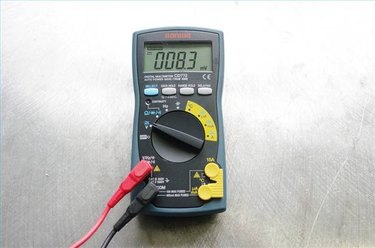
Multimeters measure AC and DC current and voltage, along with electrical resistance. Some models also measure circuit continuity, which means they can determine if a particular circuit has a path for the electricity to follow or if there is something in the way, such as a blown fuse or a shorted wire. Multimeters come in both digital and analog versions; the digital version is easier to read and more accurate, while the analog version is better for observing changes in readings. Follow the steps below to take readings with a digital multimeter.
Step 1
Test for voltage by first setting the dial to the appropriate AC or DC range for the expected voltage if your multimeter is not auto-ranging. Touch the black common probe to a grounded object and the red probe to the wire or device that you want to measure. The voltage will appear on the display.
Video of the Day
Step 2
Test for continuity by first turning off power to the circuit. Select "continuity" on the multimeter---it is represented by a symbol similar to ->+))). Touch the probes to the ends of the circuit you want to test. If you get a reading of "infinity," the circuit is open---this means you have a short or a blown fuse. A low reading means the circuit has continuity.
Step 3
Test for resistance by first turning off power to the circuit. Select "resistance" on the multimeter---it is represented by a symbol that resembles a horseshoe. Touch the probes to the ends of the circuit you want to test. Read the meter.
Step 4
Test for current by first turning off the power to the circuit. Plug the red probe into the 10A jack. Select "amps" on the dial. Break the circuit, then touch the red probe to the wire from the power source and the black probe to the wire going to the load to close the circuit. Turn the power on and read the meter. If you need to measure more than 10 amps, use a multimeter with a clamp. This is an easier way to test the current because you don't need to break the circuit---you simply clamp the multimeter over the wire.
Warning
Never attempt to measure resistance or continuity on a powered circuit. Know the limits of your multimeter model and do not attempt to measure anything that may exceed those limits.
Video of the Day